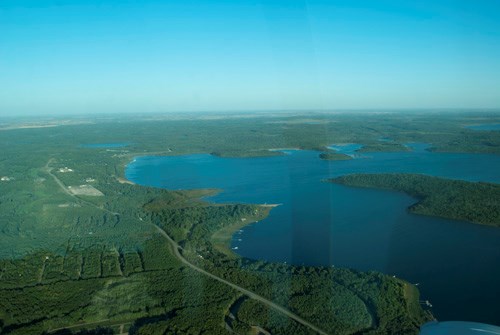In the 1800s the first European explorers to the area saw something special in the Moose Mountains and declared the area of Moose Mountain Provincial Park as a Dominion Game Management Zone.
In 1923 the provincial government took over administration and Moose Mountain Provincial Park was formed according to the Moose Mountain Water Resource Management Corp. explained it was at this time that beavers were introduced to the area. Two pair, one placed to the north of Kenosee and one pair to the south, were brought to the area from Hudson Bay and thrived.
Being as beavers alter their ecosystems greatly there were high rains in 1954, but all flow into Kenosee Lake was prevented due to beaver dams. The government was asked to step in, but nothing was done; so, local community members decided to remove four dams. This was enough to create water flow which would fill the lake.
Ideally the corporation would like to see Kenosee Lake continue to rise to a point where it is overflowing. The overflow would then make its way to White Bear Lake, which is also below the ideal water level for the lake.
Since 2008 the resource group partnered with Moose Mountain Provincial Park has worked towards keeping the watershed flowing through blasting key dams and have successfully seen the lake rise approximately nine vertical feet.
An ongoing challenge, the Moose Mountain Water Resource Management Corp. has been working with the park to continue this initiative. Having met on Wednesday, Oct. 23, for an annual general meeting the board, interested community members, and Joan Adams (Moose Mountain Park Supervisor) attended.
The two main topics discussed at the meeting included a Surface Management Plan and a Beaver Management Plan.
The Surface Management Plan was designed by Bob Godwin. Though a plan regarding the watershed is being looked into, community members have found the proposal to be misguided as it focuses on data collected in 2011. Chairman of the corporation, Bob Brickley, explained this was not comprehensive and more research was required.
During Godwin's conducted study four public meetings were held, however, the community found their input was not implemented within the draft.
"We're going to be patient and we're going to be persistent," Brickley stated.
The draft is not what the corporation was hoping for and they will continue to call for a better plan, which they are hopeful of.
"I met directly with the deputy minister and she has no problem listening to our input, so we're quite encouraged," Brickley explained.
The second plan the group discussed was the Beaver Management Plan, which they hope to implement. This plan is currently being developed through Moose Mountain Provincial Park with help from Dave Philips, who is currently mapping all of the beaver dams in the area.
The corporation feels that the beavers essentially control the watershed throughout the park and feel it is necessary to manage their populations to ensure the quality of Kenosee Lake, which ultimately affects tourism and how many people come to the area.
Adams, new to her position, spoke to the amassed crowd explaining it is the park's intention to continue working with the Water Resource group.
"It's in everybody's best interest to all work together," Adams said.
Working alongside both organizations is the local trapping association, consisting of 16 trappers, which has been integral in water management through the population control of beavers in the area to ensure the natural waterways continue to flow without being hampered by a species of animal introduced to the area by people in the 1920s.
"The trappers have worked in conjunction with this association, I'm part of the trappers as well, and they've worked very well in these areas," Brickley explained. "We select trappers that want to trap more and they'll eradicate certain areas."
Though they have been integral in the well being of the park and keeping the waters in Kenosee high, the trappers are experiencing troubles with bringing in interested young people.
"the problem with trapping today is it's not economical and the 16 trappers left it's for recreation and they're a dying breed," stated Brickley. "Hardly any young guys are coming into it and this is our concern, in another 10 to 15 years when some of us are beyond the trapping ability there probably won't be anyone to replace. That's why it's very, very important to have a beaver management plan."
Though attempting to bring young trappers into the association, it has proven difficult as the park's topography makes trapping extremely hard work.
"It's hard work, trapping in any environment is hard, especially beaver, and in the park it's extremely hard work, it's very difficult," Brickley said. "You work harder to catch a beaver in the park, so anybody interested in just catching beaver they're going to go somewhere else."
"it's just dedicated people who love the environment, love what they do, and treat it as recreational that are here. Some have come and tried it a little while, but it was short lived."
This is why Brickley and the corporation feels that an active Beaver Management Plan is essential to the longevity of the lake. Since 2008 with Gordon Locke and Linc Brickley working with the park in blasting key dams the lake has since grown by approximately half of their goal, which is overflowing. The corporation and park hope to see nine feet more of water to accomplish this, while Brickley says the people at White Bear Lake are looking forward to a rise in their water level.



.png;w=120;h=80;mode=crop)
